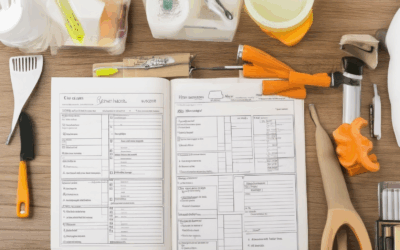Empowering yourself with DIY home repair tips can transform your approach to handling household issues, offering a practical and cost-effective solution. Whether you’re tackling minor fixes or more complex projects, mastering these skills can save you both time and money while boosting your confidence in maintaining your living space. This guide provides a comprehensive pathway, from learning the basics to exploring budget-friendly strategies and leveraging community resources like the 504 Home Repair Program. By addressing common challenges such as high repair costs and worry, this article equips you with actionable insights to take control of your home repairs, ensuring your space remains in top shape. Discover how DIY home repair tips can be your key to hassle-free living and long-term savings.

How to Learn Basic Home Repair?
Learning basic home repair skills can significantly enhance your ability to maintain your living space and save money on professional services. Here’s a step-by-step guide to getting started:
- Assess the Problem – Begin by identifying the issue you want to address. Whether it’s fixing a leaky faucet or patching a hole in the wall, understanding the problem is the first step toward solving it.
- Gather Tools – Equip yourself with essential tools like a screwdriver set, wrenches, measuring tape, and a toolkit tailored for small repairs. Explore our recommended toolkits for more details.
- Start with Small Projects – Begin with manageable tasks such as changing a light bulb, tightening loose cabinet handles, or replacing a worn-out towel rack. These simple projects build confidence and familiarity with basic tools and materials.
- Learn from Resources – Utilize online tutorials, videos, and guides to gain knowledge and techniques. Websites like DIY Hacks and Fix It Club offer valuable step-by-step guides for various home repairs.
- Practice Common Issues – Focus on frequently encountered problems like plumbing leaks, electrical outlets, and flooring damage. Tool Kingdom provides comprehensive guides for addressing these issues effectively.
- Emphasize Safety – Always prioritize safety when handling repairs. Turn off the power before working on electrical systems and wear protective gear like gloves and goggles. WikiHow offers detailed safety guidelines for various home repairs.
- Seek Community Support – Join local DIY groups or forums to share experiences and ask questions. Communities like Fix It Club foster a supportive environment for learning and troubleshooting.
Most Expensive Home Repairs
- Kitchen Renovation: Includes cabinetry, appliances, and countertops, often costing thousands.
- Bathroom Remodel: High-end fixtures, tiles, and plumbing can lead to significant expenses.
- Plumbing Replacement: Especially for water heaters and pipe systems, which can be labor-intensive.
- HVAC System Installation: Replacing old units with energy-efficient models can be costly.
- Electrical Rewiring: Updating older systems or adding circuits requires skilled labor.
- Roof Repair/Replacement: Particularly for older roofs or those needing complete replacement.
- Asbestos Removal: Necessary in older homes and involves specialized handling.
- Driveway/Patio Installation: Using premium materials can increase costs substantially.
- Structural Repairs: Addressing foundation issues requires professional expertise.
- Appliance Installation: Large items like pools tables or spas incur high labor fees.
- Exterior Improvements: New windows or siding can be expensive but vary by material quality.

How to Stop Worrying About Home Repairs
Worrying about home repairs can be overwhelming, but with the right approach, you can manage it effectively. Here’s a structured guide to help you address concerns and maintain your home:
- Create a Home Maintenance Checklist
- Monthly checks: Inspect pipes, clean gutters, test smoke detectors, and examine windows for wear.
- Quarterly tasks: Check the roof, HVAC system, and foundation for signs of damage.
- Annual inspections: Test appliances, review insurance policies, and evaluate landscaping.
- Learn Basic DIY Skills
- Start with simple tasks like organizing your toolbox or learning to use a multimeter.
- Watch tutorials on platforms like YouTube or enroll in local workshops to gain confidence.
- Set Up an Emergency Fund
- Save a portion of your income specifically for home repairs, aiming for $500-$1000.
- Research local contractors and negotiate payment options if unexpected costs arise.
- Build a Network of Reliable Professionals
- Seek recommendations from trusted friends, family, or online reviews.
- Contact local businesses listed on platforms like Yelp for referrals.
- Prioritize Preventative Maintenance
- Regularly clean and inspect areas prone to issues, like chimneys and attics.
- Consider upgrading to energy-efficient appliances for long-term savings.
- Develop an Emergency Plan
- Keep a list of emergency contacts, including trusted contractors and utility companies.
- Plan for quick access to essentials like tools and manuals during repair situations.
- Accept What You Can’t Control
- Recognize that not all repairs require DIY expertise; know when to seek professional help.
- Focus on solutions rather than dwelling on the problem.

How to Pay for Unexpected Home Repairs
When faced with unexpected home repairs, it’s essential to act quickly and efficiently to manage the situation. Here are several methods to consider:
- Emergency Savings Fund: A dedicated emergency fund is the most reliable source for covering unexpected expenses. Aim to set aside a portion of your income monthly to build this cushion.
- Personal Loan: If you have good credit, applying for a personal loan can provide immediate cash flow. Compare rates and terms to find the most affordable option.
- Home Equity Loan or HELOC: Using your home’s equity through a home equity loan or HELOC can offer competitive rates, though it comes with risks if repayment becomes challenging.
- Service Plans and Warranties: Consider service plans for appliances and systems to reduce out-of-pocket costs when repairs occur. Companies like American Home Shield and Sears Home Services provide coverage for various home systems.
- Crowdfunding: For smaller repair costs, crowdfunding platforms like GoFundMe can help gather support from friends and family.
- Local Assistance Programs: Check with local governments or housing authorities for grants or low-interest loans designed for home repairs.
Always assess your financial situation and choose the method that best fits your needs. Regularly inspect your home to prevent unexpected issues and ensure you’re prepared for future repairs.
What to Do When You Can’t Afford a Home Repair?
If you’re facing a situation where you can’t afford a home repair, don’t panic. There are several strategies you can employ to address the issue without overspending or going into debt.
- Consider DIY Solutions: Many home repairs are manageable as DIY projects. Check online tutorials or forums like Home Repair DIY Guide for step-by-step instructions. This can save you money and give you a sense of accomplishment.
- Borrow Tools or Ask for Help: If you lack the necessary tools, see if a friend or family member can lend you some. Alternatively, check if local community centers or tool libraries offer access to equipment at a low cost.
- Seek Free or Low-Cost Assistance: Contact local non-profits or organizations that provide free or discounted repair services. Groups like Habitat for Humanity often assist homeowners in need.
- Apply for Financial Aid: Explore grants or assistance programs offered by local governments, housing authorities, or NGOs. These programs may provide the funds you need to cover repair costs.
- Take Out a Loan: If the issue is urgent, consider a short-term loan specifically for home repairs. Ensure you understand the terms and can repay the loan comfortably.
- Use Coupons and Discounts: Visit local hardware stores or purchase materials online to take advantage of ongoing promotions and discounts. Some stores offer cash discounts for immediate payment.
- Negotiate with Service Providers: Don’t hesitate to discuss payment plans or discounts with contractors or service providers. Sometimes, they are willing to lower their rates for cash-paying customers or for smaller jobs.
- Prioritize Repairs: Assess the urgency of the repair and address the most critical issues first. Delaying minor repairs can prevent more costly problems later.

What is the 504 Home Repair Program?
The 504 Home Repair Program, administered through the USDA Rural Development , provides financial assistance to low-income homeowners for essential home repairs and improvements. This program is officially referred to as the Section 504 Home Repair program.
Overview
This program is designed to help very-low-income families and individuals by offering loans and grants to address critical health and safety issues in their homes. The primary goal is to ensure safe living conditions for eligible homeowners while also promoting the preservation of affordable housing.
Eligibility Criteria
To qualify for the 504 Home Repair program, applicants must meet specific income guidelines set by the USDA. Income limits vary by location and are determined based on household size and income level. Homeowners must demonstrate that they cannot afford to fix the issues themselves, often through proof of financial status and other documentation.
Types of Repairs Covered
- Roof repairs and replacements
- Plumbing fixes and upgrades
- Electrical systems repairs
- Heating and cooling system improvements
- Structural issues addressing
- Bathroom and kitchen renovations
- Lead paint removal
- Asbestos abatement
- Water and sewer system repairs
How to Apply
Applying for the 504 Home Repair program typically involves several steps:
- Contact your local USDA Rural Development office to confirm eligibility and obtain application materials.
- Complete the application form and provide necessary documentation, including proof of income, residency, and any other required paperwork.
- Submit the completed application along with supporting documents to the appropriate authority.
- Once approved, funds may be allocated to cover the cost of the repairs, which are then carried out by licensed contractors or volunteers.
Conclusion
The 504 Home Repair program is a vital resource for low-income homeowners seeking assistance with home repairs. By addressing critical health and safety issues, this initiative helps preserve the dignity and comfort of residents while ensuring the sustainability of affordable housing options.




0 Comments